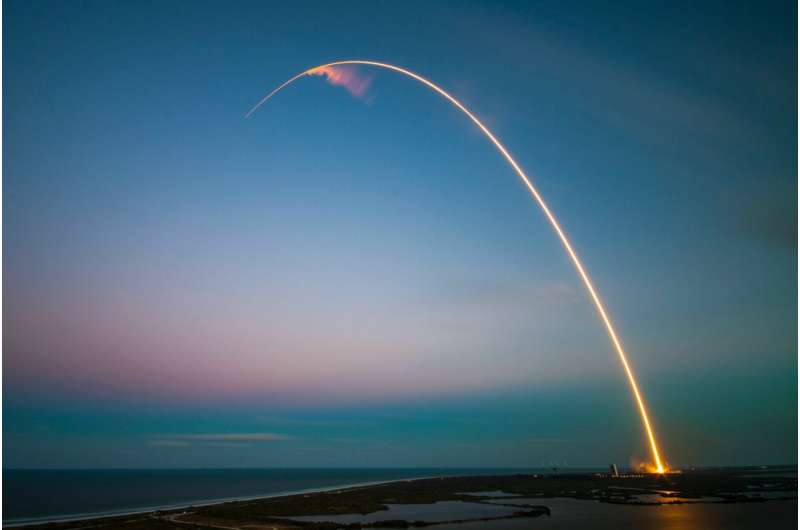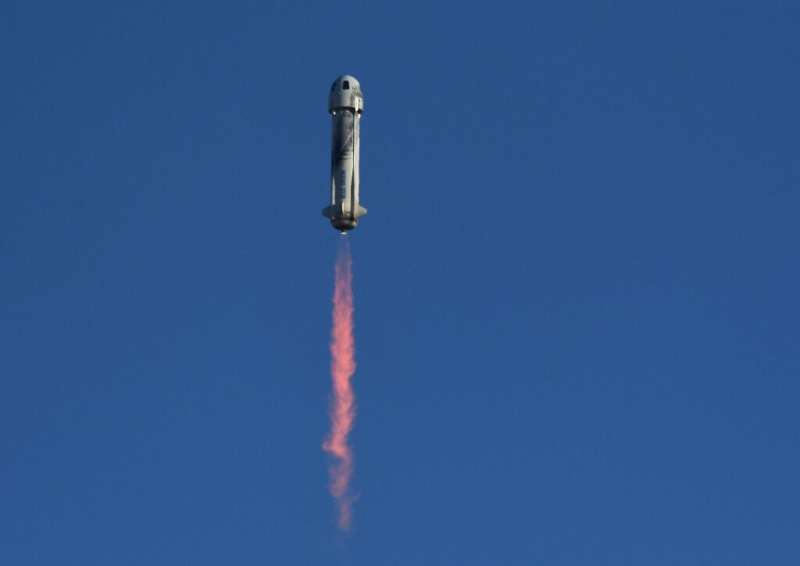
Copernical Team
Blue Origin sends first Egyptian and Portuguese nationals to space
 Jeff Bezos' Blue Origin on Thursday launched six people to space, including the first from Egypt and Portugal, on the company's sixth crewed flight.
Mission "N-22" saw the New Shepard suborbital rocket blast off around 8:58 am local time (1358 GMT) from Blue's base in the west Texas desert.
The autonomous, re-usable vehicle sent its crew capsule soaring above the Karman line, the intern
Jeff Bezos' Blue Origin on Thursday launched six people to space, including the first from Egypt and Portugal, on the company's sixth crewed flight.
Mission "N-22" saw the New Shepard suborbital rocket blast off around 8:58 am local time (1358 GMT) from Blue's base in the west Texas desert.
The autonomous, re-usable vehicle sent its crew capsule soaring above the Karman line, the intern South Korea's first lunar orbiter launched by SpaceX
 South Korea's first lunar orbiter successfully launched on a year-long mission to observe the Moon, Seoul said Friday, with the payload including a new disruption-tolerant network for sending data from space.
Danuri - a portmanteau of the Korean words for "Moon" and "enjoy" - was on a Falcon 9 rocket launched from Cape Canaveral in Florida by Elon Musk's aerospace company SpaceX. It aims t
South Korea's first lunar orbiter successfully launched on a year-long mission to observe the Moon, Seoul said Friday, with the payload including a new disruption-tolerant network for sending data from space.
Danuri - a portmanteau of the Korean words for "Moon" and "enjoy" - was on a Falcon 9 rocket launched from Cape Canaveral in Florida by Elon Musk's aerospace company SpaceX. It aims t Beyond Artemis I—NASA plots cheaper rocket rollout while Congress calls for more flights

NASA has yet to get its next-generation moon rocket off the ground, but this week announced a shift in how it plans to pay for future launches while also falling under a new directive from Congress to increase the number of flights each year.
Artemis I, a combination of the Space Launch System rocket and Orion capsule, is set to roll out from Kennedy Space Center's Vehicle Assembly Building on Aug. 18 to Launch Pad 39-B ahead of a potential liftoff as early as Aug. 29. The uncrewed test flight will send Orion on a mission that could last up to 42 days traveling more than 1 million miles including several orbits around the moon.
The primary goal is to sign off on Orion's ability to support crew for future missions, including testing a heat shield that can endure the stresses of an intense re-entry.
"Orion will come home faster and hotter than any spacecraft has before," said NASA Administrator Bill Nelson during a press conference Wednesday. "It's going to hit the Earth's atmosphere at 32 times the speed of sound.
Blue Origin sends first Egyptian and Portugese nationals to space

Jeff Bezos' Blue Origin on Thursday launched six people to space, including the first from Egypt and Portugal, on the company's sixth crewed flight.
Mission "N-22" saw the New Shepard suborbital rocket blast off around 8:58 am local time (1358 GMT) from Blue's base in the west Texas desert.
The autonomous, re-usable vehicle sent its crew capsule soaring above the Karman line, the internationally recognized space boundary, 62 miles (100 kilometers) above sea level.
"I'm floating!" a crew mate could be heard saying on a livestream, as the capsule coasted to its highest point and the passengers experienced a few minutes of weightlessness.
Both the rocket and capsule separately returned to the base—the latter using giant parachutes—completing the mission around 11 minutes after lift-off.
The final frontier? Just a slice of Spanish sausage

A red ball of spicy fire with luminous patches glowing menacingly against a black background.
This, prominent French scientist Etienne Klein declared, was the latest astonishing picture taken by the James Webb Space Telescope of Proxima Centauri, the closest star to our Sun.
Fellow Twitter users marveled at the details on the picture purportedly taken by the telescope, which has thrilled the world with images of distant galaxies going back to the birth of the universe.
"This level of detail... A new world is revealed every day," he gushed.
But in fact, as Klein later revealed, the picture was not of the intriguing star just over four light-years from the Sun but a far more modest slice of the lip-sizzling Spanish sausage chorizo.
Photo de Proxima du Centaure, l'étoile la plus proche du Soleil, située à 4,2 année-lumière de nous.
Elle a été prise par le JWST.
Ce niveau de détails… Un nouveau monde se dévoile jour après jour.
ESA testing sensor network for smart city navigation

New infrastructure added to ESA’s ESTEC technical centre in the Netherlands is helping to test how tomorrow’s smart cities will operate in practice. The HANSEL system is hosted in ESTEC’s Navigation Laboratory and allows linking to sensors across the site, providing insight into the collective networking and computing needed to get a variety of ‘intelligent elements’ to mesh seamlessly together – what the brain of a future smart city might look like.
The strength of the strong force
 Much ado was made about the Higgs boson when this elusive particle was discovered in 2012. Though it was touted as giving ordinary matter mass, interactions with the Higgs field only generate about 1 percent of ordinary mass. The other 99 percent comes from phenomena associated with the strong force, the fundamental force that binds smaller particles called quarks into larger particles called pr
Much ado was made about the Higgs boson when this elusive particle was discovered in 2012. Though it was touted as giving ordinary matter mass, interactions with the Higgs field only generate about 1 percent of ordinary mass. The other 99 percent comes from phenomena associated with the strong force, the fundamental force that binds smaller particles called quarks into larger particles called pr Through the Pass We Go Sols 3551-3552
 Curiosity is making its way through the stunning "Paraitepuy Pass," the little canyon that runs between the "Deepdale" and "Bolivar" buttes to our east and west, respectively. The canyon floor is filled with aeolian bedforms, or sand ripples, as wind is likely funneled through the pass, mobilizing sand grains - a lovely modern process, active on Mars today! Today's two-sol plan contains our norm
Curiosity is making its way through the stunning "Paraitepuy Pass," the little canyon that runs between the "Deepdale" and "Bolivar" buttes to our east and west, respectively. The canyon floor is filled with aeolian bedforms, or sand ripples, as wind is likely funneled through the pass, mobilizing sand grains - a lovely modern process, active on Mars today! Today's two-sol plan contains our norm NASA team troubleshoots asteroid-bound Lucy across the solar system
 Following the successful launch of NASA's Lucy spacecraft on Oct. 16, 2021, a group of engineers huddled around a long conference table in Titusville, Florida. Lucy was mere hours into its 12-year flight, but an unexpected challenge had surfaced for the first-ever Trojan asteroids mission.
Data indicated that one of Lucy's solar arrays powering the spacecraft's systems - designed to unfurl
Following the successful launch of NASA's Lucy spacecraft on Oct. 16, 2021, a group of engineers huddled around a long conference table in Titusville, Florida. Lucy was mere hours into its 12-year flight, but an unexpected challenge had surfaced for the first-ever Trojan asteroids mission.
Data indicated that one of Lucy's solar arrays powering the spacecraft's systems - designed to unfurl Virgin Galactic secures land for new astronaut campus and training facility
 Virgin Galactic Holdings, Inc. (NYSE: SPCE) has secured land to move forward with a new astronaut campus and training facility in the State of New Mexico, near the Company's commercial operations headquarters.
The land, located in Sierra County, will be home to a new, first of its kind astronaut campus, for exclusive use by Virgin Galactic Future Astronauts and up to three of their guests
Virgin Galactic Holdings, Inc. (NYSE: SPCE) has secured land to move forward with a new astronaut campus and training facility in the State of New Mexico, near the Company's commercial operations headquarters.
The land, located in Sierra County, will be home to a new, first of its kind astronaut campus, for exclusive use by Virgin Galactic Future Astronauts and up to three of their guests 